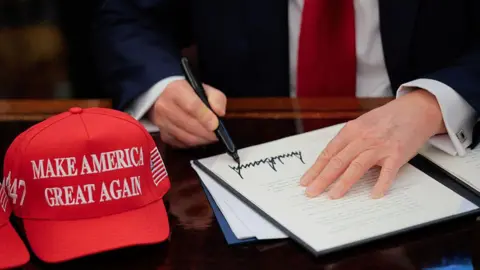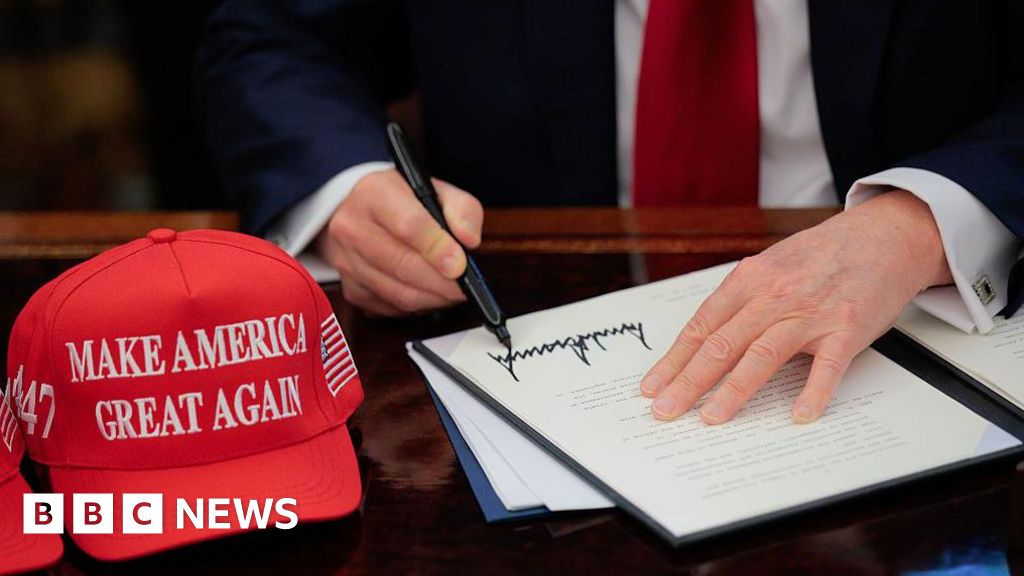Understanding Trump’s Tariff Policies: An In-Depth Look

Photo by Getty Images
What Are Tariffs and How Do They Work?
Tariffs are taxes imposed on imported goods, typically calculated as a percentage of the product’s value. For instance, a 10% tariff on a $10 item translates to an additional $1, bringing the total purchase price to $11 (approximately £8.34). Although the importing companies pay this tax, they often pass on the increased costs to consumers. This can lead to higher prices at retail stores, impacting everyday Americans and businesses alike. Additionally, these tariffs may result in reduced imports, altering trade dynamics.
Why Is Trump Using Tariffs?
President Trump advocates for tariffs as a way to bolster government tax revenue, encourage consumer spending on American-made products, and stimulate domestic investment. He aims to reduce the U.S. trade deficit—the difference between exports and imports—highlighting his belief that the U.S. has been “exploited” by foreign trade practices. Trump has also linked tariffs with unrelated issues, such as immigration and drug trafficking, demanding concessions from countries like China and Mexico in exchange for lowered or postponed duties. However, many of Trump’s tariff decisions have faced delays and legal challenges, underscored by a recent appeals court ruling declaring many tariffs unlawful.
Tariff Threats on Individual Countries
Negotiations are ongoing with several key trade partners, particularly China, Canada, and Mexico, all of which have faced severe tariff threats.
-
China: In the past, the two nations threatened to impose over 100% tariffs on each other’s goods. However, an initial truce was established, with ongoing discussions for a trade deal. The future of these tariffs remains uncertain, particularly concerning specific duties linked to fentanyl production.
-
Canada: Facing a 35% tariff on its products, most Canadian goods enjoy exemption under the United States-Canada-Mexico Agreement (USMCA). Nevertheless, tariffs on metals and automobiles have raised tensions, with Trump recently considering further increases.
-
Mexico: Similar to Canada, Mexico is subjected to a 30% tariff on certain imports. Talks regarding the specifics of these tariffs have been extended, allowing for additional negotiations about trade and crime prevention.
These tariffs vary across countries, reflecting Trump’s stance that “worst offenders” should shoulder heavier costs.
The UK Tariff Deal
The United Kingdom negotiated a relatively favorable agreement with the U.S., securing a 10% tariff rate on goods—the lowest of any country. This agreement covers significant exports, such as cars and pharmaceuticals, while allowing the UK to enjoy certain exemptions that other nations do not. Although there were discussions about completely eliminating tariffs on steel, specifics remain on hold as both nations assess their trade priorities.
A Closer Look at Affected Goods
Trump’s tariffs are not just broad strokes; they target specific products as well. This includes the elimination of exemptions for low-cost goods valued at $800 (£592) or less, impacting everyday online shopping experiences. Companies shipping these products now face various duties, which can add significant costs to low-value items—affecting everything from clothing to electronics.
Rising Prices for U.S. Consumers
Americans are already witnessing price increases. Inflation rose to 3% in the twelve months leading to September, marking a notable uptick. Categories such as groceries, which saw a 2.7% increase, are particularly impacted, with some staples like beef and coffee rising even more sharply. Retail giants such as Target and Walmart have indicated they will shift the burden of tariffs onto consumers, pushing prices higher even for domestically produced goods, particularly those reliant on imported raw materials.
Impacts on U.S. and Global Economies
When Trump announced his tariffs, many expressed concern about their potential to disrupt the global economy. Financial markets have largely stabilized since those shaky initial announcements. Still, the International Monetary Fund (IMF) reported that U.S. tariffs have adversely affected global economic stability, slightly downgrading growth forecasts. Conversely, U.S. tariff revenues have surged, with reports indicating monthly figures in June 2025 tripling compared to the previous year.
While the Congressional Budget Office projects a slight decrease in overall economic growth due to these measures, they also indicate an expected reduction in government borrowing over the next decade due to increased tariff revenues.
Through structured insight into the implications of Trump’s tariffs, it’s evident that while there are potential benefits aimed at protecting American interests, the broader impacts on consumer prices, international relations, and economic stability bring significant complexities to the forefront.



